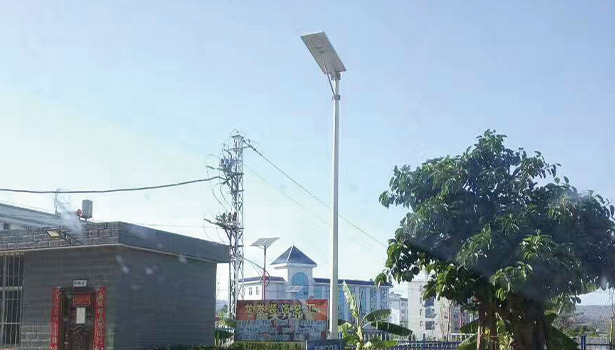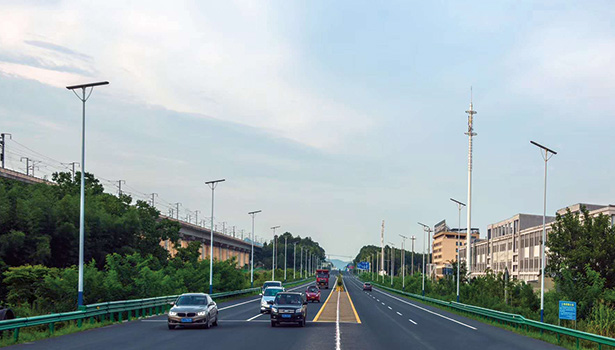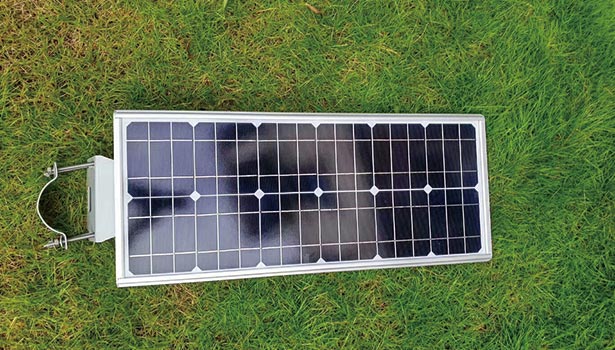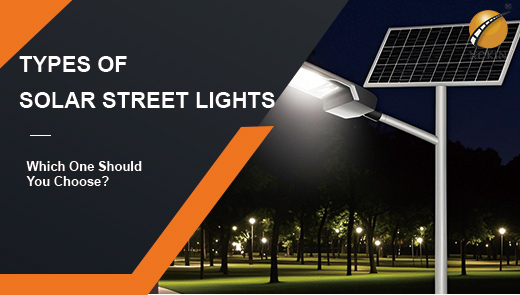Solar Street Light Basics: Everything You Need to Know for Efficient Outdoor Lighting
Globally, the application of solar street lights is becoming more and more widespread. Over the past few years, its usage has shown significant growth, and according to relevant data, in some areas, the number of solar street light installations has increased by more than 50% in just five years. This growth trend not only reflects the gradual improvement of the importance of solar street lights in the field of lighting, but also reflects its unique advantages in energy saving and environmental protection, which are being recognized by more and more people.
In this article, we will discuss the basic aspects of solar street light, covering its power source, components, types, working principle, installation methods, advantages, and answer frequently asked questions to help readers understand solar street light in all aspects.

What Type of Power Do Solar Street Lights Use?
Solar street lights, as the name suggests, are street lights that use solar energy as their power source. Solar panels, usually mounted on poles or lighting structures, use sunlight as an alternative source of energy. During the day, solar panels absorb sunlight, convert it into electricity and charge rechargeable batteries. At night, these fully charged batteries provide power to the streetlight, allowing it to glow and illuminate properly.
Solar streetlights work on the principle of photovoltaic conversion. In this process, solar cells play a central role. When sunlight hits the solar cell, the negatively charged electrons inside the cell are excited, pushing the solar energy into the positively charged space inside the cell. This marvelous process allows for the successful conversion of solar energy into direct current, specifically, solar energy is passed on to electrons, thus realizing a shift in the form of energy. After that, the cables of the solar cell are connected to the battery to transfer the DC electricity converted from the sunlight to be stored in the battery.
Basic Components of A Solar Street Light
Solar panel
The solar panel is one of the most important components of a solar street light as it undertakes the crucial task of converting solar energy into electricity. Currently, two main types of solar panels exist in the market, namely monocrystalline and polycrystalline solar panels. In terms of conversion efficiency, monocrystalline solar panels perform much better, with a much higher conversion rate than polycrystalline solar panels. This means that under the same lighting conditions, monocrystalline solar panels are able to convert more solar energy into electricity, providing more adequate power support for street lights.
Lighting fixtures
LEDs (Light Emitting Diodes) have become the dominant lighting source in modern solar street lights, with LED lamps being able to provide higher lumen values with lower energy consumption. Compared to the high pressure sodium (HPS) lamps widely used in traditional street lighting, LED lamps consume significantly less energy. In addition, LED luminaires require no warm-up time, a feature that allows them to be used in conjunction with motion detectors to further improve energy efficiency. Motion detectors quickly sense when people or vehicles are approaching and trigger the LED fixtures to come on, while the fixtures can be dimmed or turned off when no one is present or vehicles are passing by, thus avoiding wasted energy.
Rechargeable battery
Rechargeable batteries play an important role in energy storage in solar street light systems. During the day, the battery is responsible for storing the electricity converted from the solar panels; at night, when lighting is needed, the battery releases the stored energy to provide power for the lighting fixtures. The capacity of the battery is also directly related to the endurance of the street light at night, i.e., the number of days of continuous lighting.
Controller
The controller also plays an indispensable role in the solar street light system. It is mainly responsible for controlling the charging and lighting on and off. Some modern controllers have programmable functions, which allow users to set charging, lighting and dimming parameters flexibly according to actual needs. For example, in the season of sufficient light, the charging time can be shortened and the lighting time can be extended; while in the season of insufficient light, the charging parameters can be adjusted to ensure that the battery can be fully charged, and at the same time, the lighting brightness can be reasonably controlled to prolong the battery's usage time. Through this intelligent control method, not only can we improve the energy utilization efficiency of solar street light system, but also can effectively extend the service life of battery and lamps.
Light pole
A sturdy pole is an indispensable part of all street lights, and its importance is even more self-evident for solar street lights. This is because the top of a solar street light usually needs to be fitted with a variety of components, such as lamps, solar panels, and sometimes even batteries. In some new designs, the solar panel and all electronic components are integrated inside the pole, which not only simplifies the installation process, but also improves the overall aesthetics of the street light. In addition, when designing the pole, the wind resistance factor needs to be fully considered to ensure that the street light can operate stably in all kinds of adverse weather conditions. Generally speaking, the height, material and structural design of the light pole need to be reasonably selected according to the wind conditions of the actual installation location to ensure the safety and stability of the street light.

How Solar Street Lights Work?
Solar energy conversion
The work of solar street light begins with the solar energy conversion process. During the day, when sunlight strikes a solar panel, a photovoltaic effect occurs in the solar cells within the panel. Photons interact with the atoms inside the solar cell and excite electrons to escape from the atoms, forming free electrons. These free electrons move in a directional manner under the action of an electric field, resulting in the generation of an electric current. Through a series of circuit connections and conversions, this current is eventually collected and output as direct current.
Energy storage
The DC current generated by the solar panels is not immediately used for lighting, but is first stored in a battery. The batteries act as a “buffer” as an energy storage device, ensuring that the streetlights are still supplied with a stable power supply at night or in low light conditions. Solar street light systems are usually equipped with specialized charge management circuits to control the charging current and voltage, preventing the battery from being overcharged or over-discharged.
Intelligent control
Solar street light systems are also equipped with intelligent controllers to realize intelligent control of street lights. The intelligent controller can monitor the ambient light intensity in real time and control the street light to turn on and off according to the preset threshold. When the ambient light intensity decreases to a certain level, the intelligent controller will automatically trigger the circuit, the battery in the power delivery to the lighting fixtures, so that the street lamps light up; and when the ambient light intensity increases to a certain level, the intelligent controller will automatically cut off the circuit, stopping the street lamps lighting.
In addition, some advanced intelligent controllers also have a dimming function, which can adjust the brightness of the street light according to the actual demand, and further improve the efficiency of energy utilization. Through this intelligent control method, solar street lights can not only realize automatic lighting, but also flexibly adjust the working status according to different environmental conditions and actual needs, maximizing the advantages of solar energy.
Lighting
When the night falls or the ambient light intensity decreases below the preset threshold value of the intelligent controller, the lighting process of the solar street light officially starts. At this time, the electrical energy in the battery is transmitted to the lighting fixtures through the circuit, and the LED fixtures convert the electrical energy into light energy, emitting bright light and providing illumination for the road. As LED lamps have the advantages of high efficiency, energy saving and long life, they can provide high-quality lighting effects with low energy consumption, creating a safe and bright traveling environment for pedestrians and vehicles.
Continuous operation
One of the significant advantages of solar street light is that it can realize continuous operation. During the daytime, solar panels will continue to collect solar energy and convert it into electricity to be stored in the battery, ready for nighttime lighting. As long as there is enough sunlight during the day, the batteries are continuously recharged, ensuring that the street light will function properly at night. Even in the case of continuous cloudy days or insufficient light, through the reasonable configuration of the battery capacity and the selection of efficient solar panels, the solar street light can rely on the stored electricity to maintain lighting for a certain number of days.

Solar Street Light Installation
Comparison between integrated and split installation
Currently, the solar street light installation methods on the market are mainly divided into two types: integrated installation and split installation. Integrated solar street light usually adopts the integrated design, which integrates the solar panel, lamps, batteries and controllers in a whole structure, and only needs to be fixed on the pre-set pole during installation, which makes the installation process simple and fast, without the need of complicated on-site assembling and debugging. In contrast, the split solar street light needs to be assembled and connected at the construction site, which makes the installation process relatively cumbersome and requires more time and labor costs.
Installation process of split solar street light
Installation of solar panel bracket:
First of all, the solar panel mounting bracket needs to be firmly installed on the light pole. The position and angle of the mounting bracket need to be precisely adjusted according to the actual light conditions to ensure that the solar panel can receive maximum sunlight irradiation. Generally speaking, the solar panel should face due south (in the northern hemisphere) and maintain a certain tilt angle with the ground, which is usually adjusted according to the local latitude and season to obtain the best light effect.
Installation of luminaire arm:
The luminaire arm used to fix the luminaire is connected to the pole for installation. The length and angle of the arm also need to be adjusted according to actual needs to ensure that the luminaire can accurately illuminate the desired area. During the installation process, attention needs to be paid to the firmness of the arm to avoid shaking or falling during use.
Installation of solar panels:
Install the solar panels on the pre-installed bracket and make sure the connection between the panels and the bracket is firm and reliable. In the connection process, you need to pay attention to the direction of the positive and negative poles of the solar panel to avoid reversing the connection, resulting in the inability to charge properly. At the same time, the solar panel also needs to be properly fixed and protected to prevent damage under adverse weather conditions.
Installation of LED fixtures:
Install the LED fixtures at the end of the fixture arms and make sure the fixtures are installed at the correct position and angle. During installation, attention needs to be paid to the sealing performance of the luminaire to prevent rain or dust from entering the interior of the luminaire, which could affect the service life of the luminaire. In addition, it is necessary to make electrical connections to the luminaire to ensure that the luminaire can properly receive power supply from the battery.
Wiring:
Perform the wiring between the solar panel and the LED fixture. If the lamps with built-in charge controllers are used, only the output line of the solar panel and the input line of the lamps can be connected, and the wiring process is relatively simple. However, if the external charge controller is used, it is necessary to connect the output line of the solar panel, the input line of the luminaire and the charge controller, and the wiring process is relatively complex.
In the wiring process, it is necessary to pay attention to the specifications and quality of the wires to ensure that the wires can withstand sufficient current, and at the same time, it is also necessary to provide appropriate protection and fixation of the wires to avoid the wires from being pulled or abraded by external forces. In addition, it is also necessary to carry out the wiring connection between the lamps and batteries, connecting the output line of the battery with the input line of the lamps and lanterns, in order to realize the function of the battery to provide power for the lamps and lanterns.
Erecting the light pole:
The assembled light pole is erected in a pre-excavated ground pit and the pit is filled with concrete to ensure the stability of the light pole. In the process of erecting the pole, it is necessary to pay attention to the verticality of the pole to avoid the tilt of the pole affecting the light-gathering effect of the solar panels and the lighting effect of the lamps. At the same time, the light pole also needs to be properly fixed and protected to prevent the light pole from being hit or damaged by external forces in the process of use.
Connecting the battery:
After the light pole is erected and stabilized, install the battery in the battery box and connect the wires between the battery and the light fixture or charge controller to complete the whole installation process. When connecting the battery, you need to pay attention to the direction of the positive and negative connection of the battery, to avoid reversing the connection to cause damage to the battery or not work properly. At the same time, the battery also needs to be properly fixed and protected to prevent the battery from vibration or collision during use.

Why Go With Solar Street Light?
Electricity supply constraints
In some remote, mountainous or rural areas, there are often many difficulties in power supply. Due to their remote location or poor infrastructure, these areas are difficult to be covered by traditional power grids, or even if they are covered by power grids, there may be unstable power supply or even no power supply at all. In this case, if the local solar energy resources are abundant, then solar street lights become an ideal lighting solution. Solar streetlights can rely on solar power to generate electricity without the need to rely on the traditional power grid, thus providing stable and reliable night lighting for these areas. For example, in some mountainous villages, due to the complex terrain, the cost of laying the power grid is extremely high and difficult, while the emergence of solar street lamps effectively solves the problem of night lighting for the local residents and improves the quality of life of the residents.
Energy saving and environmental protection
Solar streetlights do not rely on grid power, which means they can avoid lighting interruptions caused by power outages or grid failures. Compared with traditional streetlights that use alternating current (AC), solar streetlights are powered by low-voltage direct current (DC), which greatly reduces the risk of electrocution. At the same time, the use of low-voltage DC power also reduces the possibility of fire caused by short circuit or overload. In addition, the charging and discharging control system of solar streetlights is usually equipped with protection functions such as overcharging, over-discharging and short-circuiting, which further improves their safety. From an environmental point of view, solar street lights utilize solar energy as a clean energy source, which does not produce any pollutants during the use process and has almost no negative impact on the environment. Compared with traditional streetlights, the use of solar streetlights can significantly reduce the emission of carbon dioxide and other greenhouse gases, making a positive contribution to the fight against global climate change.
Safe and Reliable
Since solar streetlights do not rely on the power grid, even in extreme situations such as natural disasters, such as earthquakes and floods that cause the power grid to paralyze, solar streetlights can still work normally to provide the necessary lighting support for the affected areas and safeguard people's lives and property. At the same time, the solar street light system is also more stable, and its main components, such as solar panels, batteries and lamps, have been carefully designed and rigorously tested to have a long service life and good reliability. Under normal use, solar street light can maintain stable lighting effect for many years, reducing the cost of frequent maintenance and replacement required due to equipment failure.
Convenient Installation
The installation process of solar street lights is relatively simple and quick, without the need to lay complicated cables and pipes. Compared with traditional street light installation, this greatly reduces the construction difficulty and cost. At the same time, the integrated and split design of solar street light makes it more flexible for installation and can adapt to many different application scenarios, such as city streets, rural roads, remote mountain roads, parking lots and squares. Whether in the open plains or in the mountainous areas with complicated terrain, the solar street light can be easily installed and commissioned, providing a convenient solution for the lighting needs of different areas.

Solar street lights are gradually becoming an important choice for modern lighting due to their unique power source, various types, efficient working mechanism, convenient installation and significant energy saving and safety advantages. Whether it is to solve the problem of power supply in remote areas or to respond to the global call for energy saving and emission reduction, solar street lights show great potential. It is hoped that readers will have a more comprehensive and in-depth understanding of solar street lights through this article, and prioritize this sustainable lighting solution in the planning of future lighting projects, contributing to the creation of a greener, safer and more convenient living environment.




